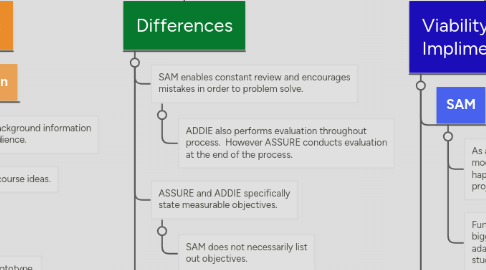
1. Reference:
1.1. Arshavskiy, M. (2013). Instructional Design for ELearning: Essential guide to creating successful eLearning courses.
2. Similarities
2.1. Preparation
2.1.1. Gather background information about audience.
2.1.2. Develop course ideas.
2.2. Design
2.2.1. Create prototype.
2.2.2. Implement design.
2.3. Evaluation
2.3.1. Determine student success levels.
2.3.2. Reflect and problem solve effectiveness.
3. 3 Models
3.1. SAM
3.1.1. Preparation Phase
3.1.1.1. Background information gathered.
3.1.1.2. Collaboratively brainstorm project ideas with others.
3.1.2. Iterative Design Phase
3.1.2.1. Prototype
3.1.2.2. Evaluate
3.1.2.3. Design
3.1.2.4. Review, make decisions, and refine prototype to avoid critical mistakes (Arshavskiy, 2013).
3.1.3. Iterative Development Phase
3.1.3.1. Develop
3.1.3.2. Implement
3.1.3.3. Evaluate
3.1.3.4. Expects mistakes to be made and ability to make corrections along the way (Arshavskiy, 2013).
3.2. ASSURE
3.2.1. Analyze Learners
3.2.1.1. Characteristics of learners, learning styles, motivational aspects of learning (Arshavskiy, 2013).
3.2.2. State Objectives
3.2.2.1. Develop specific and measurable objectives.
3.2.3. Select Media and Materials
3.2.3.1. Develop and modify materials and media to utilize for course.
3.2.4. Utilize Media and Materials
3.2.4.1. Implement selected materials in a way easy for all learners to access.
3.2.5. Evaluate and Revise
3.2.5.1. Determine of objectives were met.
3.2.5.2. Consider editing or revising course based on findings.
3.3. ADDIE
3.3.1. Analysis
3.3.1.1. Clarify problems, define objectives, collect data.
3.3.1.2. Define audience, content, learning environment, and technical requirements.
3.3.2. Design
3.3.2.1. Write objectives and develop sequencing of course.
3.3.3. Development
3.3.3.1. Brings design to life via text, storyboards, graphics, audio, video (Arshavskiy, 2013).
3.3.4. Implementation
3.3.4.1. Delivery of information to audience.
3.3.5. Evaluation
3.3.5.1. Assessment by measuring the level of audience's learning.
3.3.5.2. Success of project goals being met.
4. Differences
4.1. SAM enables constant review and encourages mistakes in order to problem solve.
4.1.1. ADDIE also performs evaluation throughout process. However ASSURE conducts evaluation at the end of the process.
4.2. ASSURE and ADDIE specifically state measurable objectives.
4.2.1. SAM does not necessarily list out objectives.
4.3. SAM focuses on collaboration.
4.3.1. ASSURE and ADDIE seem to focus on individual student success.
5. Viability of Implimentation
5.1. SAM
5.1.1. As an artist, mistakes are bound to occur. Through the SAM model, students are encouraged to allow mistakes to happen in order to utilize critical thinking throughout the project.
5.1.2. Furthermore, as an educator, no unit is complete. The biggest take away from the SAM model is to continue to adapt the lesson to the needs and learning techniques of the student.
5.2. ASSURE
5.2.1. Create specific and measurable objectives.
5.2.1.1. Using Adobe Photoshop, students will create original artwork based on Tilt-Shift techniques scoring 85% proficient on an accompanying scoring guide.
5.3. ADDIE
5.3.1. ADDIE addresses the need to identify any potential problems.
5.3.1.1. For example, students may not have access to Adobe Photoshop at home. So the unit objectives must allow enough class time for students to successfully complete the assignment.
5.3.2. Development allows for a variety of methods to pass information to students.
5.3.2.1. Use of the SmartBoard to show students how to use different Adobe Photoshop tools.
5.3.2.2. YouTube videos
5.3.2.3. Toolbar guides
